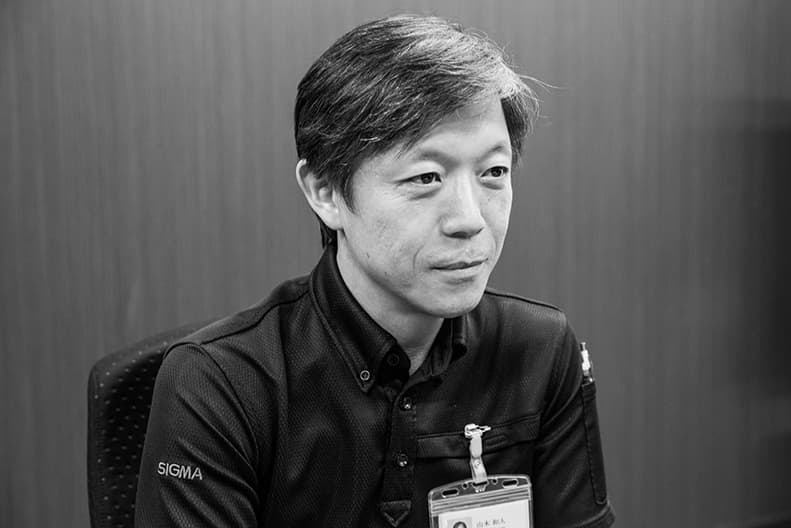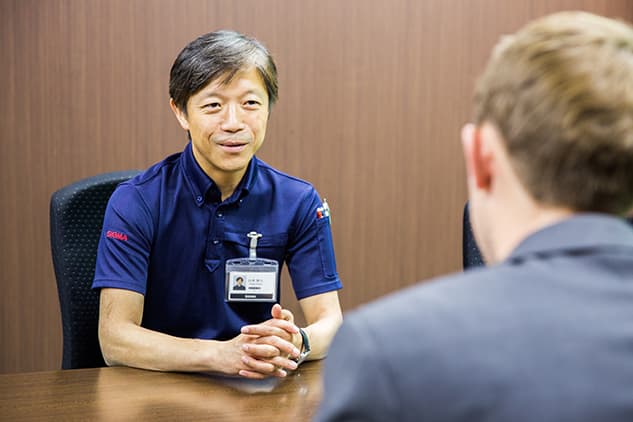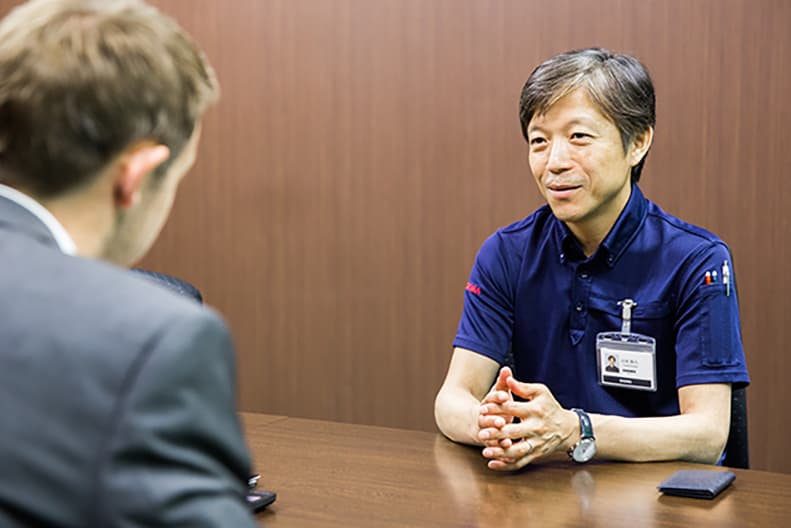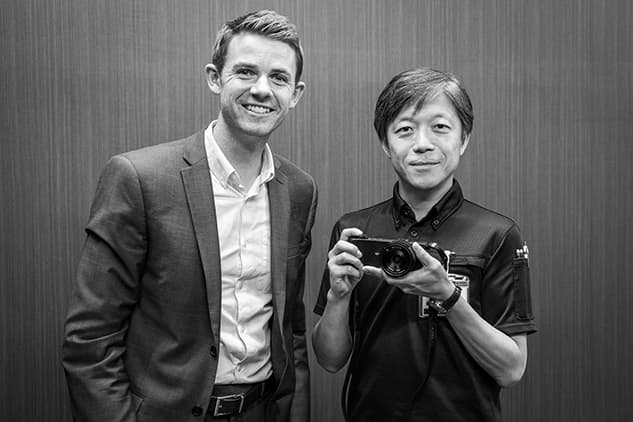During a recent visit to Japan, Amateur Photographer took the opportunity to visit Sigma’s production facility in Aizu and spoke to Kazuto Yamaki, CEO of Sigma Corporation. After a tour of the extensive production facility, AP’s Michael Topham spoke with Kazuto Yamaki, who answered questions about Sigma lenses, the new Sigma sd Quattro and the company’s ambitions for the future.
Interview conducted on the 15th June 2016 (16:00) at Sigma Corporation, Aizu, Japan
AP: Sigma has advanced a long way from where they were ten years ago. Can you explain what influenced this change?
KY: First, in the mid-1990s the Japanese yen became very strong against the US dollar. In order to reduce production costs, many companies decided to move their production sites to the likes of China, Thailand and Vietnam, but we [Sigma] decided to stay in Aizu to protect our employees. If we stay in Aizu the production costs are very high, but if we had moved the production site offshore we’d have to lay off the people here. We didn’t want to do that. This is one of the reasons why we decided to change the business domain from low-end products to the mid-to-high-end products. The unique price is higher than the low end, but we believe we can survive here.
AP: Sigma has produced some exceptional lenses in recent years. Are we at the point where you consider Sigma to be a premium brand producing premium products?
KY: It’s a great honour to be a premium brand, but we don’t want to be a luxurious premium brand. We want to stay pure and be considered a technological company. We always try to produce the best-quality products at a reasonable price and that’s the mission of Sigma.
AP: What has been the most important technological development during the time you have worked at Sigma?
KY: It’s not a single technique that makes a high-quality product – it’s an accumulation of the technology in each segment. Aspherical glass is one of the biggest developments, but there are plenty of smaller innovations besides that make a high-quality product. It’s the reason why few new companies can get into this market. In the case of the mobile device, LCD displays are rather simple technology. If a new company can invest the money into the factory or new technology they can catch up very quickly. In the case of interchangeable lenses, a new company needs to accumulate experience and knowledge in the technology. This is why new companies simply cannot produce high-quality products in the short term. It’s a really time-consuming process to acquire the required experience in the technology.
AP: Sigma produces lenses for beginners, enthusiasts and professionals. Would you say there has been a greater emphasis on producing high-end products than mass market ones in recent years?
KY: I would say yes, but this doesn’t mean that we have forgotten about the entry-level products. There are two reasons for producing high-end products. One is economics. If we have high-end products there is more room to absorb the high production costs and therefore it makes sense for us to produce more high-end products. Also, most of the engineers, including myself, are photo enthusiasts. We are really passionate about making high-quality products. It’s more fun to make the best optics than normal low-priced products. It’s our passion.

Kazuto Yamaki, CEO of Sigma Corporation, Photo credit. Paul Reynolds, Sigma Imaging UK
AP: What sparked the idea of offering users the option to calibrate their own lenses and has the uptake of the USB dock been successful?
KY: I think it has been quite successful, and there are two reasons for this. First, when we were making the USB dock, we knew the market was already saturated. When the market is growing everyone wants to have similar things, and one or two particular models, whether it be cameras or lenses, can become very popular. Manufacturers have had an easy life to produce popular products. After saturation, people’s interests tend to diversify and this leads to customisation – it’s a normal process. We wanted to prepare for customers who wanted to customise their equipment. In the past, when I was the manager of the software engineering division, we were always talking about what is the best balance, and we understood there is always a trade-off. If we prioritise faster autofocus, the smoothness of a lens’s operation can reduce when focusing and lenses can suffer from hunting. We always try to find the best balance, but we are always concerned that some customers want to prioritise faster speed than the smoothness of the focusing. We wanted to ensure our customers have the option to choose so we developed the USB dock for this purpose.
AP: There have been reports that three Sigma Art lenses are not fully compatible with the new Canon EOS-1D X Mark II. What’s the issue and how will it be resolved?
KY: We will release new firmware that will provide users with a free update. Anyone who owns the USB dock can update the firmware of a Sigma lens free of charge. We have already developed the firmware and it’s coming very soon.
AP: What does Sigma do to ensure lenses are compatible with all cameras at the time they are launched?
KY: We check our lenses with all existing cameras, but we do not know what cameras lie ahead in the future. Sometimes we encounter such issues, but we’re working on solutions and I’m pretty sure in the future customers will experience fewer compatibility issues with our lenses.
AP: What’s does Sigma see as the greatest challenge at the moment with regard to lens design?
KY: It’s always a matter of trade-off. If we want the highest quality, the lens naturally becomes very bulky and people do not want to use a super-bulky lens. We always consider the balance between the quality, the size and the cost. The difficulty is the preferences of each customer are different. Also, users in the US and users in Japan are different, so to find the best balance is extremely challenging. This is one of the reasons we’ve created the three lens categories – Art, Sports and Contemporary. Contemporary represents a very traditional approach to the design of the optics. We take the best balance between the performance, cost, size and weight. We don’t say that Contemporary is a low-end product, as we always try to achieve the best quality. In the case of the Art and Sport lines, we break the balance of the three elements and prioritise quality. The lens naturally becomes bulkier and heavier, but some serious professional and enthusiast photographers prefer such a lens. That’s why we produce the three categories.
AP: If you were to speculate, do you think Sigma’s future will lie in producing lenses for DSLRs or mirrorless cameras?
KY: Both. Our goal is to produce high-quality lenses for the photo enthusiast. In the future, I believe the traditional DSLR and mirrorless cameras will co-exist. We therefore need to provide lenses for both camera systems. In the future, I think mirrorless models will be dominant and the DSLR will remain as more of a special-purpose camera.

Kazuto Yamaki, CEO of Sigma Corporation speaking to AP’s Michael Topham during our interview. Photo credit: Paul Reynolds, Sigma Imaging UK
AP: There are popular mirrorless systems out there, which Sigma currently does not support – Fujifilm’s X-series being one such example. Will we see Sigma expand the lineup for more mirrorless cameras?
KY: We are studying whether we expand our range for other systems. In the case of Fujifilm, they do not disclose information, so in order to support the Fujifilm system we’d have to carry out the reverse engineering ourselves. This takes a really long time – a minimum of a year and maybe longer. We need to therefore carefully select which systems to support and we continue to carefully monitor the market. We know that Fujifilm is doing quite well and they’re increasing their share in the market. Fujifilm’s customers are photo enthusiasts, and they’re the typical target customer for Sigma, so we need to study this carefully.
AP: We understand from Sigma UK that the April earthquakes in Kumamoto had no impact on production and will not affect Sigma’s plans for Photokina. How did Sigma manage to escape being affected when most other camera makers say production will suffer?
KY: Most of the camera manufacturers are suffering a supply shortage from the Sony image-sensor factory. According to the news the factory was badly affected, but we don’t buy our sensors from Sony. Semi-conductor factories were also affected by the earthquake, but this isn’t a major component part so the impact on our production is small.
AP: What inspired the creation of the Mount Converter MC-11?
KY: I know many photographers who use the EOS system together with the Sony E-mount system and they change systems based on the situation. I personally believe this will continue in the future because of the strengths of both systems. Even if the future of the EVF is better than it is today, it won’t be better than an optical viewfinder in terms of the image quality. If photographers own two systems, they have to invest in lenses for both. We’d like to provide the solution for these types of photographers. When we developed the 50mm f/1.4 lens we wanted to make sure there’s no difference in quality when it’s used with a Sony mirrorless camera fitted with our adapter. It wouldn’t make sense for us to produce a similar size, similar-quality lens just for Sony, so we wanted to make an adapter for Sony users.
AP: The sd Quattro and sd Quattro H are both intriguing new cameras. Who are they specifically out to target?
KY: It’s made for photo enthusiasts. We have very loyal Sigma users, but other potential customers include those who own Canon, Nikon and Sony cameras.
AP: Are there any plans to build the line-up in this area?
KY: In the future we’d like to have more cameras in our product line and we’ll probably continue the Quattro series.

AP’s Deputy Technical Editor, Michael Topham asks the questions. Photo credit: Paul Reynolds, Sigma Imaging UK
AP: How well does the sd Quattro H perform at high ISO in low light?
KY: I think there is room for improvement with the performance in low light. Compared to the existing camera, we’ve made small improvements.
AP: Some have said that the dp Quattro compact was bulky and awkward when it was launched. What have consumers fed back to you, and are there any plans for more similar-shaped bodies?
KY: We know that it’s bulky compared to the previous ones, but one of the reasons for this is so that it can disperse the heat more effectively. Many customers are happy with the design of the dp Quattro.
AP: How many sd Quattro and sd Quattro H models do you expect to produce and sell?
KY: I have no idea.
AP: Are there any plans for the sd Quattro and sd Quattro H’s raw files to be supported in Adobe Camera Raw or Lightroom?
KY: I really hope that Adobe supports our file system in the future, but it’s really their matter. Adobe are the ones who decide whether or not they support our format. We are very happy to work with them.
AP: Sigma is well known for its quirky, eccentric camera designs. Are there any plans for slightly more sensible camera designs in the future?
KY: I like the classic design of cameras, especially those made in the 1960s and ’70s. The Leica M is still the most beautiful camera, but copying such beautiful styling is a different story. Even if we copy the style, our camera won’t look as great as the old ones. In my opinion, our company needs to be at the centre of innovation, so even though we personally like the classic design, we want to challenge ourselves with a new design. It’s the only way to develop a new type of camera.
AP: Can Sigma sustain manufacturing cameras in the long run? As we understand it, the lens side of the business is much more profitable than the part making new cameras?
KY: Yes, we make money from the lenses and use that money for our camera development. There’s a huge amount of loss from making cameras, but it’s our dream to make the highest-quality camera since my father’s time. My father had a great dream to make the best-quality camera using unique technology. Having taken over the business from my father, it’s my obligation to take over his dream.

Mr Kazuto Yamaki explaining there are exciting things to come from Photokina 2016. Photo credit: Paul Reynolds, Sigma Imaging UK
AP: Where does Sigma see the next leap in technology coming from regarding interchangeable-lens cameras?
KY: There are many technologies that can be improved for photographers, with dynamic range being one example. Sigma wants to provide a camera that offers even better image quality. When I first saw a print taken by an 8×10 film camera, I was very impressed by the quality and we’d love to make something similar. We want to produce the best quality possible.
AP: The camera industry has suffered from a decline in demand over recent years. Has the smartphone and tablet affected Sigma?
KY: We are not affected yet, but the general market will shrink even further. I don’t think it’s because of the smartphone. Maybe the compact camera is affected by the smartphone, but DSLR, mirrorless and high-end cameras are in a different category. It’s true the market is shrinking, but this is mainly because of the lack of innovation. If manufacturers successfully create innovative products, people want to buy them. We have great potential to grow in the market.
AP: Should AP readers have reasons to be excited at Photokina, as far as Sigma is concerned?
KY: We are preparing some new exciting products and I’m pretty sure your readers will be excited. I hope they’re looking forward to the announcement from us.
AP: What’s Sigma’s strategy for the remainder of 2016 and going into the future?
KY: The industry is suffering from a shrinking market and, as I said previously, this is mainly because of a lack of innovation. Sigma is trying to develop something new that has never existed before. Last year we developed a 24-35mm f/2 zoom lens – it’s the first f/2 zoom lens for full frame. We also developed the 20mm f/1.4, which is the first 20mm lens with a maximum aperture of f/1.4. We’ll continue with this strategy. We always try to create new innovation to stimulate the market. We’ll try to develop new products that have never existed in the past. There are many types of demands from customers, so one of our missions is to try to produce a solution and even better quality products. Some customers want small, light, well-balanced glass and we’ll provide these products. Some people have complained in the past that they’ve had to invest twice in lenses for the EOS and Sony E-mount systems, so we have created the MC-11 Mount Converter adapter. It’s our mission to provide some kind of solution to the customer’s complaint.
Sigma 50-100mm f/1.8 DC HSM | A Review
In the last few days we’ve published our full review of the new Sigma 50-100mm f/1.8 DC HSM | A lens – the manufacturer’s second f/1.8 zoom lens for APS-C DSLRs. Check out our full review.
To read more Sigma lens reviews simply head to our lens reviews page.







